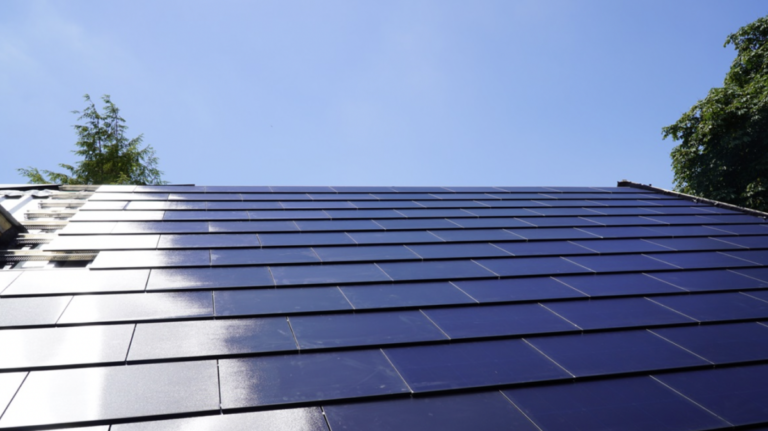Paxos Solar has developed a new glass-glass PV tile that can be integrated with heat pumps, using Longi’s back-contact solar cells. The 44W, 59.5cm x 48cm tile can also produce heat for residential systems.
Paxos Solar, a German specialist in building-integrated photovoltaic solar energy (BIPV), has developed a new solar tile that not only generates electricity, but also produces heat for heat pumps.
The tile is a small glass-glass module measuring 59.5 cm x 48 cm and provides a power of 44 W. Approximately 4.3 tiles would be installed per square meter, giving a total power of 190 W.
The modules are equipped with highly efficient back contact cells from the Chinese Longi. They are completely black on the front with a matte structured surface that catches oblique light. Paxos Solar technical director Julian Münzberg said the modules are produced by a partner in China.
“The flat solar tile is larger than other products on the market,” says Münzberg. This speeds up installation and also provides more force on the surface. Connections to windows or chimneys can be cut to any size, and there is no need to use an additional roof tile.”
The company uses the modules to create multi-energy roofs. It initially lays a layer of inexpensive trapezoidal plates over the insulation to serve as a dense, aquifer layer. Support rails are then mounted on this layer, in which the glass roof tiles are hung. To this end, each tile is provided with a glued rail at the bottom edge. The top edge of the next module overlaps and presses on the bottom module.
Because the solar panels do not overlap on the sides, but are pushed together with a space of 1 mm, some water can seep through and run off the trapezoidal plate.
The lower edge of the roof and the support rails, which run over raised beads, are perforated and allow air to pass through. When sunlight heats the air under the modules, it rises between the raised ridges towards the roof ridge and collects in a pipe.
“As soon as the temperature is at least one Kelvin above the ambient temperature, it is worthwhile to switch on the integrated pipe fan and blow the warm air to the heat pump,” says Münzberg.
The Technical University of Cologne has tested and measured the concept, says Guido Schumacher, CFO and partner at Paxos Solar. The heat pump at the university required 20% less energy during the year compared to a comparable device without the additional heat generation. The heated air was led to the suction pipe of the heat pump, which was installed under the roof. For longer distances, insulated spiral seam or stainless steel pipes can be used.
Schumacher says one square meter of the flat solar tile, including trapezoidal plates and mounting rails, costs €260. This means that 1 kWp corresponds to a material value of € 1,400. Initial customer installations showed that setting up a multi-energy roof takes approximately half the time of traditional roofing and installation. The roof also weighs 31 kg per square meter, making it lighter than standard concrete roof tiles.
In addition to the black flat tile, Paxos PV offers beavertail roof tiles for monumental buildings.
“There is a lot of interest in our roof tiles, especially from owners of monumental buildings,” says Schumacher.
The company plans to install solar panels on approximately 200 roofs in the coming year. It is financing further growth through a crowd investment campaign that aims to raise 1.2 million euros in 80 days. Investors can start with $100, and those who invest more than $25,000 will receive company shares.
Paxos Solar is also behind a PV roof tile that Meyer Burger will sell and is currently putting into series production.
This content is copyrighted and may not be reused. If you would like to collaborate with us and reuse some of our content, please contact: editors@pv-magazine.com.


